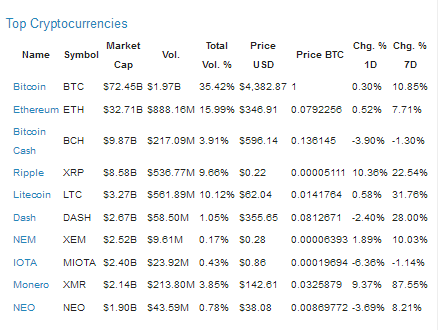DOW – 5 = 21,808
SPX + 1 = 2444
NAS + 17 = 6283
RUT + 4 = 1382
10 Y – .01 = 2.16%
Oil – 1.06 = 46.81
Gold + 18.70 = 1310.50

The Weather Company’s chief meteorologist called it “a tragedy of epic proportions.” The National Weather Service said it was “unprecedented” and “beyond anything experienced.”
National attention has been focused on Texas since Friday, when Hurricane Harvey hit the coast. The hurricane is now a tropical storm and it has moved back out over water. The storm is expected to head back to land over the next 48 hours, skirting Houston to the east and taking dead aim at Beaumont.
The problem with this storm is not so much the winds which devastated Rockport Texas, but the rains which are expected to continue for the next 3 to 4 days. Houston has already received more than 2 feet of rain. So much rain has fallen, the National Weather Service had to update the color charts on their graphics, anything over 20 inches is deep purple.
According to the National Hurricane Center, 50 inches of rain in total could end up falling on Houston and Galveston and other cities along the coast. That means the already serious flooding will only get worse.
Rivers, creeks and bayous around Houston are expected to crest tonight. The Army Corps of Engineers began releasing water from overwhelmed reservoirs in Houston to stymie some of the flooding in the city’s downtown, though the procedure could flood additional homes.
There are also ongoing threats from tornadoes and storm surge. Five deaths have already been reported, and officials expect the toll to rise. Tens of thousands of people could have to take refuge in shelters.
Ten oil refinery plants around Houston and Corpus Christi are shut down, according to a report by S&P Global Platts. Goldman Sachs estimates the hurricane has taken 3 million barrels a day of refining capacity offline. Among the companies cited in the report as shutting down refineries are Exxon Mobil (NYSE:XOM), Valero, Citgo, Shell (LON:RDSa), and Phillips 66 (NYSE:PSX).
The storm has, so far, shut down one-quarter of oil production from the Gulf of Mexico. More refinery shutdowns are expected. In the short-term, this will likely mean higher gasoline prices. And while the storm will curtail offshore crude oil production in the Gulf of Mexico, crude futures dropped today. That’s because the supply impact is more than offset by the hit to demand for crude by the refinery shutdowns.
Several pipelines were also closed, potentially stranding crude in Texas and interrupting gasoline supplies to other parts of the country. The refineries will not be accepting new shipments of crude, but that also means there will be a shortage of gasoline. So today oil dropped while gasoline prices jumped.
At the pump, retail gasoline prices were moving higher, with the U.S. national average at $2.377 a gallon, a rise of 1.5 cents from Sunday and 4.6 cents from a week ago, according to fuel data site GasBuddy. Gas prices are up about 14 cents per gallon over the past 12 months.
Domestic energy stocks were slammed today. Exxon down 0.3% and Chevron (NYSE:CVX) down 0.4%. Refiner Valero Energy (NYSE:VLO) climbed 1.1 percent.
Other commodities were also hit today. Cotton futures in New York rose as much as 2.6 percent to 69.95 cents a pound. Texas is the largest U.S. cotton producer, even as many farmers are storing excess supplies on fields following a bumper harvest.
The deluge of rain has left some animals stranded in floodwater in the state that leads the U.S. in beef production. Cattle futures on the Chicago Mercantile Exchange rose as much as 2.6 percent today, reaching the highest price in almost three weeks.
The hurricane has also disrupted air travel across the country, as Houston’s 2 main airports Hobby and International are flooded, resulting in close to 2,000 flight cancellations.
If past patterns are any indication, gross domestic product data will reflect a negative impact from the hurricane in the third quarter and the fourth quarter will look stronger. But gross domestic product does not paint an accurate picture of the economic damage from an event like Hurricane Harvey.
Houstonians will lose homes and cars. Insurance these days is paying for less and less. This will be a huge hit to household wealth not captured in the GDP statistics. The standard way to measure the economy through GDP doesn’t measure the stock of wealth that’s lost.
For example, many people will have to replace their damaged cars. When they buy a new one that shows up as stronger GDP, but that GDP number does not consider that the earlier car was destroyed. Travelers Insurance was the largest drag on the Dow today, with a 2.6 percent drop.
Early reports suggested many Houstonians don’t have flood insurance. So, while auto policies might cover submerged cars, homeowners’ policies will not cover submerged homes. There will be enormous uninsured losses. Harvey’s cost could mount to $30 billion when including the impact of relentless flooding on the labor force, power grid, transportation and other elements that support the region’s energy sector, Chuck Watson, a disaster modeler with Enki Research.
That would place it among the top eight hurricanes to ever strike the US.
David Havens, an insurance analyst at Imperial Capital, said the final tally might be as high as $100 billion. Less than a third of Harvey’s losses are likely to be insured. Typical insurance policies cover wind but not flooding, which often proves costlier.
In the Houston area, rainfall already has surpassed that of tropical storm Allison in 2001, which wreaked roughly $12 billion of damage in current dollars. In that case, only about $5 billion was covered by insurance. Most people with flood insurance buy policies backed by the federal government’s National Flood Insurance Program.
As of April, less than one-sixth of homes in Houston’s Harris County had federal coverage. The federal program itself is already struggling with $25 billion of debt. The existing program is set to expire on Sept. 30 and is up for review in Congress.
This is not the first hurricane to hit the Houston area. Go back just a few years and remember Rita and Ike. More people died evacuating than the damage caused by Hurricane Rita. For Harvey, no evacuation was called. This is just an example of the lessons learned and not learned by experience. And the lessons here are important.
Houston is a low-lying area, with clay soil that does not absorb water quickly, and as Houston has grown to the fourth largest city in the country, it has been paved over; so, when it rains, the water has nowhere to go. The big question is why the Gulf Coast area is not better prepared for these extreme weather events.
Across government, virtually the entire philosophy of disaster relief is to react after disaster strikes rather than help communities and residents to prepare in advance. This leaves Congress funding billions in disaster aid when an investment of millions ahead of time could have warded off the worst. And the problem is only likely to grow as a warmer climate brings more frequent and severe hurricanes, floods and droughts.
And although preventing damage is widely considered to be cheaper than mopping up after the fact, congressional accounting creates incentives to spend money exactly the opposite way: Disaster relief bills are generally considered emergency spending, and thus not counted toward the federal deficit, while proactive investment in planning and protection must be funded through the normal budget cycle, which makes it look like cuttable federal spending at budget time.
This is Day One of the Amazon (NASDAQ:AMZN).com-Whole Foods merger. You can now buy an Amazon Dot or Echo at Whole Foods. And you might also notice that the food costs less, not cheap, just not as expensive. Amazon has demonstrated that it is willing to invest to dominate the categories that it decides to compete in. Food retailers of all sizes need to look hard at their pricing strategies.
Imagine being a tech company with so little profit that you could buy a grocery store and cut prices all while improving your margin. The other tech giants, Apple (NASDAQ:AAPL), Alphabet (NASDAQ:GOOGL), Microsoft (NASDAQ:MSFT) and Facebook (NASDAQ:FB), have operating margins for the latest quarter ranging from 23 percent to 47 percent. That’s the percentage of profit left after subtracting all the costs of goods sold as well as expenses for research and development, sales and marketing and administration.
Amazon’s operating margin for the second quarter was a paltry 1.7 percent. Whole Foods recorded operating profit of 4.8 percent. That means Jeff Bezos could cut Whole Foods margins in half and still have stronger margins than before.
Kite Pharmaceuticals (NASDAQ:KITE) shares surged 28% after Gilead Sciences (NASDAQ:GILD) agreed to buy the immunotherapy developer in a deal valued at $11.9 billion.
Tomorrow will be a challenge. Dow futures are about 100 points lower after Japan’s Prime Minister Shinzo Abe announced that North Korea fired a missile over Japan. The missile traveled more than 1600 miles Japan took no action to shoot down the projectile. Japanese broadcaster NHK reported that the North Korean missile broke into three pieces and fell into the sea. The U.S. Department of Defense said it is still assessing the missile launch.
NHK also reported that the Japanese government has convened an emergency meeting of its response team to collect and analyze information. The South Korean government has called for a national security council meeting.
